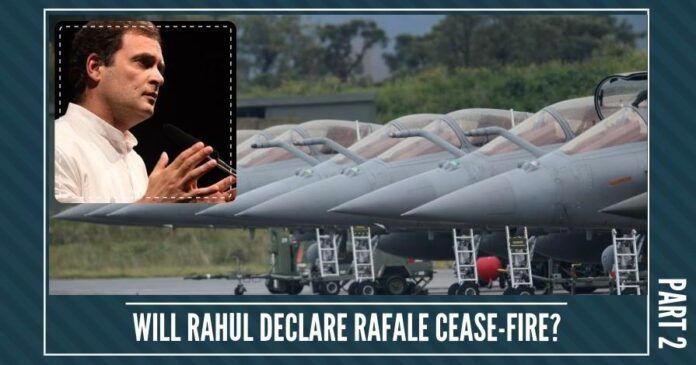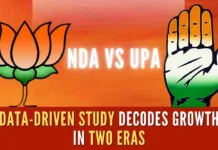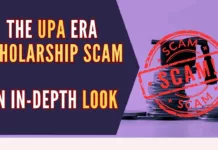
The previous part of this article When will Rahul end his obsessive ruckus over the Rafale jets? can be accessed here. This article deals with the Narrative before & After Sonia’s UPA.
To begin his self-reformation, Rahul Baba must begin at the take-off. That was when the Indian Air Force, being reduced to 34 fighter squadrons due to obsolescence, went to the ruling government in Delhi with its request for a minimum of 42 fighter squadrons to achieve an optimal capability. (One fighter squadron has 18 jets).
When asked about the procurement of Rafales, UPA’s Defence Minister A K Antony said, “There is no money left. All major projects have to wait till April 1,
Narrative Before & After Sonia’s UPA
What phenomenal work our Prime Minister and the Defence Ministry did in the Rafale issue in only 15 months after becoming PM are capsulated by the “The Times of India” of 23rd November 2017.
The most important parts of the cited article tell us is the following:
(a) The original proposal to buy 126 fighter aircraft was first mooted during Atal Bihari Vajpayee’s NDA government. The Request For Proposal (RFP) for procurement of 126 MMRCA (Medium Multi-Role Amnti Aircraft) was finally issued in 2007 when, remember, the UPA of Sonia Gandhi was in power in Delhi.
(b) IAF conducted technical evaluations and flight evaluations, and in 2011, Rafale was declared L-1 bidder in 2012, and contract negotiations began with its manufacturer, Dassault Aviation, that year.
(c) Contract negotiations remained incomplete even after two years, in 2014 due to a lack of agreement on various terms of RFP compliance and cost-related issues.
(d) There was no deal under the UPA Government. Transfer of Technology remained the primary issue of concern between the two sides. Dassault Aviation was also not willing to take the responsibility of quality control of the production of 108 aircraft in India. While Dassault provisioned for 3 crore man-hours for production of the aircraft in India, Hindustan Aeronautics Limited (HAL)’s estimate was nearly three times, thereby escalating costs manifold.
(e) What the above “Times” narrative does not reveal is that, as a matter of fact, the UPA government had not objected to a Memorandum of Understanding being signed between Dassault Aviation and Reliance Industries Limited (RIL) headed by Mukesh Ambani, not Anil Ambani, his younger brother. That happened in February 2012.
(f) Sources had then said that Dassault Aviation, a major player in the global aerospace industry, had entered into a MoU with RIL for “pursuing strategic opportunities of collaboration in the area of complex manufacturing and support in India.” It was hoped by the proposed partnership that public sector unit Hindustan Aeronautics Limited will be the lead player in absorbing the offsets in the mega Indian project of manufacturing 118 Rafale aircraft after India’s contract negotiation committee and Dassault conclude their negotiations six-eight months from now.
(g) If (f) above is a stunner, what was a final shocker was the statement by the UPA’s Defence Minister, A.K.Antony after inaugurating Defexpo 2014 at Pragati Maidan in Delhi. When asked about the procurement of Rafales, he said, “There is no money left. All major projects have to wait till April 1,” he said. And we all know that Antony’s Prime Minister was someone supposed to be a famous economist!
Rahul changes the Ambani contract value almost as often as he speaks on the issue; the last figure he mentioned was of Rs.45 crore.
Major Facts of Modi Government’s Rafale Deal
(a)The 36 MMRCA Fighter Jets are, by a signed agreement, to be supplied by Dassault Aviation to the Indian Air Force. The deal, finalised on September 23, 2016, was valued at Euro 7.87 billion (Rs.59,000 crore approximately) according to a report in “The Week” publication.
(b) One major issue raised repeatedly by our much-pampered Rahul Baba is about the price of these Rafale Jets; his contention has been that the price which the Modi government has agreed to is higher than that at which the UPA had negotiated in its deal. Nothing can be further from the truth. Firstly, the UPA never signed any deal at all with Dassault! Further, the NDA has repeatedly stated that the NDA pricing is, in fact, lower than what the UPA was negotiating for. Rahul is not willing to argue further until he is given the price of each Rafale Jet. The NDA’s argument against accepting this demand is that the Government-to-Government agreement is “Confidential” or “Secret”. That too is not acceptable to Rahul Baba, despite being contradicted by Mr. Macron, the President of France. Rahul Baba, you see, does not that just the price of a product is indicative of what quality it is. Translate this with weaponisation of a Fighter Jet and you’ll understand why the nation’s enemies. Once the enemy knows the kind of weapons, mechanical-cum-electronics equipment in an Indian jet fighter, it stands well-equipped for a suitable response to an Indian assault on it. The problem here is how one can ask a colour-blind person to choose between saffron and green.
(d) Again, Rahul Baba frequently sniggers at Anil Ambani getting a contract for Rs. 30 crores from Dassault only because Narendra Modi proposed his name and backed him. In the process, “LD’ Rahul changes the Ambani contract value almost as often as he speaks on the issue; the last figure he mentioned was of Rs.45 crore.
The truth is that, right now, Reliance Defence is targeting a business of Rs.21 crore. With an offset from Dassault Aviation and a new expected joint venture with Thales, a Dassault partner, the target is expected to go up to Rs 45,000 crore. And Anil Ambani is not going to manufacture aircraft, as he thinks. Instead, the two companies will form part of a group of companies that will produce mechanical parts and sub-assemblies. The Thales-Reliance venture not only plans to build technologies for Rafales in India and worldwide, but also will ‘develop Indian capabilities to integrate and maintain radar and electronic warfare sensors’. And just for Rahul’s information, Anil Ambani, though not known to be an aviation industrialist, can always call on Dr. Vivek Lall, a world-renowned aerospace and defence leader, having headed the Defence and Space division of Boeing, who has done considerable work for Reliance and is very close to Mukesh Ambani.
Nor does Rahul seem to know that, as per policy and the NDA’s contract with Dassault, the Offset contract to an Offset party of its choice. And Dassault has done that with at least 72 companies/firms. The names of several such firms have been actually named in Parliament by our junior defence minister Subhash Bhamre.
In fact, I sincerely request Rahul Baba, aged 48 now, to read the above Defence magazine as well as the respected Indian Defence Review. If he does that, he will hopefully tie his tongue on Modi and Rafale and thereby do a lot of good to the nation.
He is the son of an Italian mother and he may be a British citizen for his business affairs, but he still has a love of India, doesn’t he?
“TIMES OF INDIA” ATTACHMENT IS BELOW
“The Times of India’s” 10 Facts of Rafale Deal (Published on November 23, 2017)
1. The Indian Air Force (IAF) requires a minimum of 42 fighter squadrons to achieve optimal capability but between 20o0-2012 its actual strength declined to 34 squadrons due to obsolescence.
2. The original proposal to buy 126 fighter aircraft was first mooted during Atal Bihari Vajpayee’s NDA government. The Request For Proposal for procurement of 126 MMRCA was finally issued in 2007. (In power in Delhi then was the UPA, remember)
3. IAF then conducted technical evaluations and flight evaluations and in 2011, declared that Rafale and Eurofighter Typhoon had met its criteria.
Rafale was declared L-1 bidder in 2012 and contract negotiations began with its manufacturer, Dassault Aviation, that year.
4. Contract negotiations remained incomplete even after two years, in 2014, due to a lack of agreement on various terms of RFP compliance and cost related issues.
5.There was no deal under the UPA Government. Transfer of Technology remained the primary issue of concern between the two sides. Dassault Aviation was also not willing to take the responsibility of quality control of production of 108 aircraft in India. While Dassault provisioned for 3 crore man hours for production of the aircraft in India, HAL’s estimate was nearly three times, thereby escalating costs manifold.
6. When Narendra Modi became the Prime Minister in 2014, he inherited the vacuum in IAF’s fighter capabilities. During his visit to France in 2015, India and France announced a government-to-government deal wherein the Government of India would acquire 36 Rafale jets in fly-away condition as quickly as possible. According to the joint statement issued then, the two countries agreed to “conclude an Inter-Governmental Agreement for supply of the aircraft on terms that would be better than conveyed by Dassault Aviation as part of a separate process underway; the delivery would be in time-frame that would be compatible with the operational requirement of IAF; and that the aircraft and associated systems and weapons would be delivered on the same configuration as had been tested and approved by Indian Air Force, and with a longer maintenance responsibility by France.”
8. The proposals were presented to the Defence Acquisition Council on 3 occasions and its directions were incorporated. The proposal then got a Cabinet Committee on Security (CCS) nod after which the IGA happened between India & France in 2016.
9. On costs, NDA government has insisted that it got significantly better terms than those quoted in the original bid under UPA, with a total reported saving of more than 1600 million Euros (350 million Euros on the cost of aircraft with a further reported saving on weapons, allied maintenance and training package amounting to a around 1300 million Euros or Rs 12,600 crores). However, a cost breakdown of Rafale in the original bid under UPA and in the 36 aircraft in the government-to-government deal under NDA are not in the public domain.
10. There was no agreement on the terms of Technology Transfer previously. What was on offer was just Licence Manufacturing technology. Under the current agreement, the 36 Rafale procurement offset proposal supports the ‘Make In India’ initiative of the Indian Government through Article 12 of the IGA. It states that the French Party will facilitate the implementation of ‘Make In India’ by the industrial supplier notably through offsets for 50% value of the supplied protocol. The Offset proposal also includes provisions for transfer of sophisticated design technology which is meaningfully superior to the licensed manufacturing on offer in the earlier 126 MMRCA nonstarter. These critical design technologies are presently under discussion between the two governments. The present IGA was signed purely between two sovereign governments and no private individual, firm or entity was involved in the process from the Indian side. The procurement process also does not involve any Indian private party
(http://timesofindia.indiatimes.com/articleshow/61769792.cms?)
- To Editors’ Guild; May we also have our say… please? - July 17, 2019
- Farooq Sahab is either down with dementia or he is a congenital liar? - July 8, 2019
- Shah Bano, Muslims in gutter &Zakaria’s secularism - June 30, 2019











It is just audacious how less they care about nation’s interest in their political expediency.